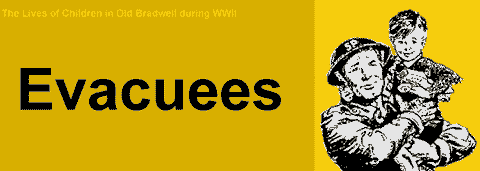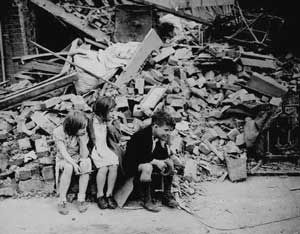 |
|||||||
| "We must prepare in good time against the possibility of war, however remote that possibility may be."
The above are the opening words of a Ministry of Health leaflet issued in January 1939. By September of that year Britain was at war and the biggest relocation of people ever undertaken in this country had taken place. The leaflet was issued as part of the preparation for this mass Evacuation. The government had divided the country into three types of area (according to the risk of bombing raids). Big cities were "Evacuation areas", this meant that people who didn't need to be there would be given the opportunity to go to a safer place. These safer places were called "Reception areas". The third type was called "Neutral" this meant that the risk of air raids was not high enough to warrant evacuation but still great enough not to send evacuees there. |
|||||||
|
Billeting Fees
Per Week 1 Child - 10s 6d (52p) More than one child - 8s 6d (42p) each |
|||||||
| Preperations
Old Bradwell was a reception area and for local people that meant making room for the expected evacuees. Jim Smith was the landlord of the Queen Victoria pub and a local councilor, he was appointed as Billeting officer for Old Bradwell. It was his job to make a list of empty houses and people who would be willing to make space in their homes for Evacuees. Local residents would have received leaflets listing the fees they would receive for taking in an evacuee. This fee was to include accommodation and food. Under 5's were to be accompanied by their mothers and lodging only provided at a weekly rate of 5s (25p) per adult and 3s (15p) per child. Meanwhile in the evacuation areas parents were receiving letters asking them to register their children for evacuation. The scheme was voluntary but parents were strongly advised to let their children go. Evacuation Problems When War was declared most people expected enemy attacks to start straight away, but this did not happen, This encouraged many parents to return their children to London. By February 1940 the clerk of Wolverton Urban District Council (Mr. B Cussons) reported that half of the evacuees received the previous September had returned. When the bombs did begin to fall those who had gone back found conditions in the communal shelters rather unpleasant; May Garner explains. With conditions in London getting worse the flow of evacuees to this area increased. The school record shows numbers reaching a peak in October 1941 with 60 children and 2 teachers crammed into the tiny school room which measured 7.30m square and was more used to numbers of 30 or less. They Locked Their Doors With the arrival of more and more evacuees local billeting officers found it difficult to find people who were willing to take them in. Despite newspaper advertisements describing the care of evacuees as "a national service" many locals were determined not to help. One local billeting officer described it like this; "as soon as people saw the bus (carrying evacuees) in the street, they locked their doors and either went upstairs or went out so that no one would open the door." Eventually places were found but only after the adoption of compulsory billeting powers and the threat of a £50 fine for those who refused. |
|||||||
